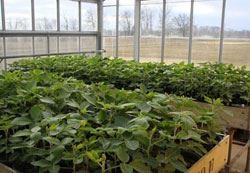SIU Adds Disease-Resistant Soybean Lines
CARBONDALE, ILL.
Southern Illinois University Carbondale is helping Midwest soybean farmers combat a parasitic roundworm – the soybean cyst nematode, sometimes referred to as the “billion dollar pest.” And they are using the soybean itself to do it.
Stella K. Kantartzi, associate professor in the Department of Plant, Soil, and Agricultural Systems and principal investigator in the Plant Breeding and Genetics Lab, announced the release of two new conventional germplasm soybean lines that are showing high resistance to soybean cyst nematodes (SCN), “SIU14-2935” and “SIU14-3125.” The SIU Soybean Germplasm and Variety Committee approved the line’s release for this month. This means the lines are available for breeding programs or for companies who want to increase the line and release it as a commercial variety.

“Research that has an immediate industry application is an important component of our mission as a research university,” said Chancellor Rita Cheng. “SIU is working to address a problem plaguing agriculture, and we are enhancing soybean production in Illinois and the Midwest.”
Because chemical control is not effective against SCN, the most efficient ways to reduce SCN-related disease in soybean fields are to rotate crops and to use disease-resistant varieties. That means cultivation of disease-resistant soybean varieties is a high priority in Illinois, which is the second-largest soybean-producing state. Illinois has 10 million acres of land seasonally devoted to soybeans in a $3 billion industry.
SCN attacks the leaves and stems and kills the roots of the plant or suppresses their growth. This leads to yield loss to the tune of $500 million annually nationwide.
The two SIU-developed germplasm lines have a common genetic background and are both early maturity group IV soybeans. Germplasm refers to the hereditary material of germ cells. In addition to resisting the SCN, these two new SIU-produced lines also show high yield potential in a variety of environments. Field evaluation trials in six different environments in Southern Illinois fields – near Belleville, Carbondale, Dowell, Harrisburg, Sandoval and Ullin – show high yield with average performance of more than 54 bushels per acre.
SIU tested the lines in USDA Uniform Tests for northern states and in a variety of environments. In the combined analysis, SIU14-2935 and SIU14-3125 averaged 54.1 and 54.7 bushels per acre, respectively. They were also tested in the SCN Regional Test and proved highly resistant to Type 0 (Race 3) soybean cyst nematodes. In both tests, SIU14-2935 and SIU14-3125 ranked in the top five advanced breeding lines.
SIU released both soybean lines because of their usefulness for breeding programs in the Midwest due to their competitive yield, high resistance to SCN and their relatively good protein and oil content. The university’s Agronomy Research Center will maintain seed and make available small quantities for research purposes. For more information, contact Kantartzi at kantart@siu.edu.
SIU Carbondale researchers have been approaching the SCN problem from different angles, including groundbreaking studies of the genetic code of disease-resistance in the soybean. Kantartzi has been active in producing several other varieties since joining SIU Carbondale in 2008.∆